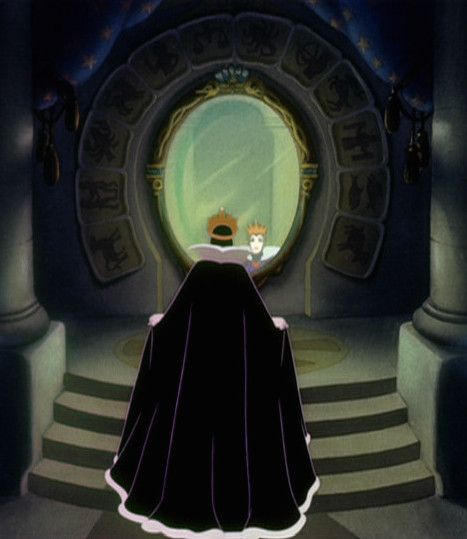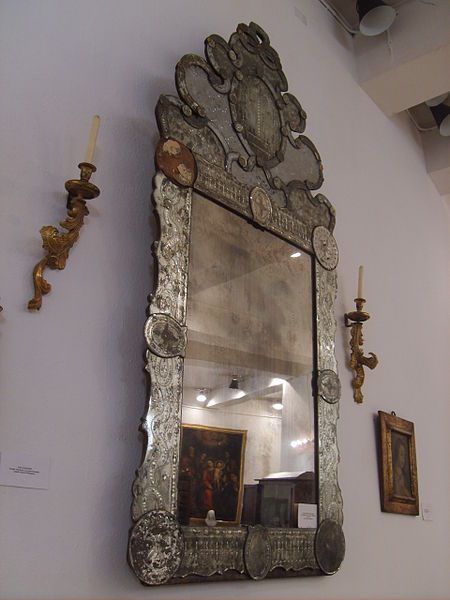
POOLS OF LIGHT
How do mirrors work? Generally speaking, by reflecting light. Most objects don’t give off any light of their own. They can only be seen because light from other sources -the sun, a candle, a light bulb- hits them and bounces off, hitting our eyes. Not all of the light bounces, though. Some is absorbed by the object and some is transmitted through the object. The part that does bounce back is the reflection. Flat shiny surfaces like water, metal, and mirrors reflect light well because very little of the light is absorbed or transmitted -most of it is reflected.
When light hits a mirror, it bounces off in the opposite direction, but at the exact same angle it came from. It appears as if the image is coming from behind the mirror, but it’s not -what we see is a virtual image.
THE FIRST MIRRORS
 For
centuries, mankind’s only mirrors were pools of water or polished
metal. The first glass mirrors were made by Venetian craftsmen in the
1300s. Their method: They covered the back of a piece of glass with an
amalgam of tin and mercury, rubbed flat and smooth. A piece of wool
cloth would then be laid on top of the mercury and pressed with iron
weights for more than a week. Then the excess mercury would be drained
off. This method remained a carefully guarded secret, and for centuries
Venice had a monopoly on mirrors.
For
centuries, mankind’s only mirrors were pools of water or polished
metal. The first glass mirrors were made by Venetian craftsmen in the
1300s. Their method: They covered the back of a piece of glass with an
amalgam of tin and mercury, rubbed flat and smooth. A piece of wool
cloth would then be laid on top of the mercury and pressed with iron
weights for more than a week. Then the excess mercury would be drained
off. This method remained a carefully guarded secret, and for centuries
Venice had a monopoly on mirrors.
In 1665 the chief minister to Louis XIV of France went to Italy and -at the risk of death- bribed 18 Venetian mirrorsmiths to move to France. Soon after their defection, the French passed a law making it illegal to import Venetian mirrors.
Three years later, a Frenchman named Louis Lucas beat the Venetians at their own game -he invented plate glass. Venetians only knew how to make blown glass, so each mirror started out as a bottle or cylinder which was slit open and flattened while still hot. The size of mirrors was therefore very limited.
But Lucas discovered
how to pour molten glass onto an iron table where it could be flattened
with an iron roller. Now mirrors could be made that were much larger.
Soon France became famous for its mirrors. A very pleased Louis XIV
purchased 700 mirrors and lined an entire hallway at the Palace of
Versailles with them in a stunning display.How do mirrors work? Generally speaking, by reflecting light. Most objects don’t give off any light of their own. They can only be seen because light from other sources -the sun, a candle, a light bulb- hits them and bounces off, hitting our eyes. Not all of the light bounces, though. Some is absorbed by the object and some is transmitted through the object. The part that does bounce back is the reflection. Flat shiny surfaces like water, metal, and mirrors reflect light well because very little of the light is absorbed or transmitted -most of it is reflected.
When light hits a mirror, it bounces off in the opposite direction, but at the exact same angle it came from. It appears as if the image is coming from behind the mirror, but it’s not -what we see is a virtual image.
THE FIRST MIRRORS
 For
centuries, mankind’s only mirrors were pools of water or polished
metal. The first glass mirrors were made by Venetian craftsmen in the
1300s. Their method: They covered the back of a piece of glass with an
amalgam of tin and mercury, rubbed flat and smooth. A piece of wool
cloth would then be laid on top of the mercury and pressed with iron
weights for more than a week. Then the excess mercury would be drained
off. This method remained a carefully guarded secret, and for centuries
Venice had a monopoly on mirrors.
For
centuries, mankind’s only mirrors were pools of water or polished
metal. The first glass mirrors were made by Venetian craftsmen in the
1300s. Their method: They covered the back of a piece of glass with an
amalgam of tin and mercury, rubbed flat and smooth. A piece of wool
cloth would then be laid on top of the mercury and pressed with iron
weights for more than a week. Then the excess mercury would be drained
off. This method remained a carefully guarded secret, and for centuries
Venice had a monopoly on mirrors. In 1665 the chief minister to Louis XIV of France went to Italy and -at the risk of death- bribed 18 Venetian mirrorsmiths to move to France. Soon after their defection, the French passed a law making it illegal to import Venetian mirrors.
Three years later, a Frenchman named Louis Lucas beat the Venetians at their own game -he invented plate glass. Venetians only knew how to make blown glass, so each mirror started out as a bottle or cylinder which was slit open and flattened while still hot. The size of mirrors was therefore very limited.
UPON FURTHER REFLECTION
In 1835 German chemist Justus von Liebig discovered a way to make a better mirror. He invented a process for using silver as a backing instead of tin and mercury. He flushed the glass with silver salts and then covered it with a solution of silver nitrate. After being heated and left undisturbed for an hour, a chemical reaction caused the metallic silver to separate and adhere to the glass. Then it was coated with shellac and painted with a black backing. And that’s how mirrors were made for the next 150 years.
In mirror making today, silver or aluminum is vaporized, then sprayed onto glass. For finer mirrors -such as those used in telescopes- aluminum, chromium, or gold are heated in a vacuum tank. When they reach the critical temperature, they “flash” into vapor, filling the tank with metallic gas. A film is then deposited on whatever material inside the tank.
MIRROR FACTS AND TRIVIA
* In the 1600s, the Dutch used to cover their mirrors with curtains when not in use, lest the reflectiveness be used up!
* In ancient China, reflective pieces of polished brass were placed over doorknobs so that evil spirits would scare themselves away.
 *
A middle school in Oregon was faced with a unique problem: A number of
girls were beginning to use lipstick and would apply it in the bathroom.
That was fine, but for some reason, they would also press their lips to
the mirrors, leaving dozens of little lip prints. Finally the principal
called all the girls to the bathroom. She explained that the lip prints
were a major problem for the custodian and asked the custodian to
demonstrate how difficult it was to clean one of the mirrors. He
proceeded to take a long-handled brush, dip it into the nearest toilet,
and scrub the mirror. After that, there were no lip prints on the
mirrors.
*
A middle school in Oregon was faced with a unique problem: A number of
girls were beginning to use lipstick and would apply it in the bathroom.
That was fine, but for some reason, they would also press their lips to
the mirrors, leaving dozens of little lip prints. Finally the principal
called all the girls to the bathroom. She explained that the lip prints
were a major problem for the custodian and asked the custodian to
demonstrate how difficult it was to clean one of the mirrors. He
proceeded to take a long-handled brush, dip it into the nearest toilet,
and scrub the mirror. After that, there were no lip prints on the
mirrors.
In 1835 German chemist Justus von Liebig discovered a way to make a better mirror. He invented a process for using silver as a backing instead of tin and mercury. He flushed the glass with silver salts and then covered it with a solution of silver nitrate. After being heated and left undisturbed for an hour, a chemical reaction caused the metallic silver to separate and adhere to the glass. Then it was coated with shellac and painted with a black backing. And that’s how mirrors were made for the next 150 years.
In mirror making today, silver or aluminum is vaporized, then sprayed onto glass. For finer mirrors -such as those used in telescopes- aluminum, chromium, or gold are heated in a vacuum tank. When they reach the critical temperature, they “flash” into vapor, filling the tank with metallic gas. A film is then deposited on whatever material inside the tank.
MIRROR FACTS AND TRIVIA
* In the 1600s, the Dutch used to cover their mirrors with curtains when not in use, lest the reflectiveness be used up!
* In ancient China, reflective pieces of polished brass were placed over doorknobs so that evil spirits would scare themselves away.
* Ben Franklin mounted mirrors outside his second-story window so he could secretly see who was knocking at his front door.
* The vanity license plate “3M TA3” was banned after someone looked at it in the mirror.
* The word mirror comes from the Latin mirari, meaning “to wonder at.” It’s also the root word for miracle and admire.
* The vanity license plate “3M TA3” was banned after someone looked at it in the mirror.
* The word mirror comes from the Latin mirari, meaning “to wonder at.” It’s also the root word for miracle and admire.
* The world’s largest mirror to date was built by scientists at the University of Arizona for the binocular telescope on Mount Graham. The mirror is 8.4 meters in diameter (almost 28 feet) and cost $4 million to make. The mirror was 2,156°F when it was first cast and took three full months to cool. It went into use in 2005.
* In older days some thought that the reflection of the body in a shiny surface or mirror was an expression of the spiritual self, and therefore if anything happened to disturb the reflection, injury would follow. This was the origin of the superstition that breaking a mirror would bring seven years of bad luck.
* Trade secret: Building managers install mirrors in lobbies because people complain less about waiting for slow elevators when they’re occupied looking at themselves.
* In 1994 Russian astronauts orbiting in the Mir spacecraft tried using mirrors to reflect sunlight into northern areas of their country in an attempt to lengthen the short growing season. It didn’t work.
* Ever wonder if the mirror in the dressing room is a real mirror or a two-way mirror? Here’s a simple test: Place the tip of your fingernail against the reflective surface. If there’s a gap between your fingernail and the image, it’s a genuine mirror. But, if your fingernail directly touches the image, watch out -it’s a two-way mirror.

No comments:
Post a Comment